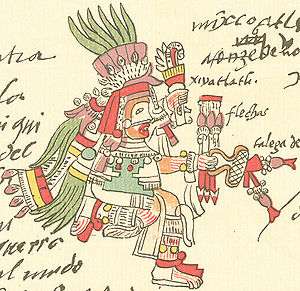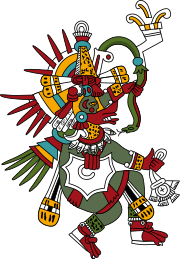Mixcoatl

Mixcoatl (Nahuatl: Mixcōhuātl, [miʃˈkoːwaːt͡ɬ] from mixtli [ˈmiʃt͡ɬi] "cloud" and cōātl [ˈkoːaːt͡ɬ] "serpent"), or Camaztle [kaˈmaʃt͡ɬe] from camaz "deer sandal" and atle "without".[1] was the god of the hunt and identified with the Milky Way, the stars, and the heavens in several Mesoamerican cultures. He was the patron deity of the Otomi, the Chichimecs, and several groups that claimed descent from the Chichimecs. While Mixcoatl was part of the Aztec pantheon, his role was less important than Huitzilopochtli, who was their central deity. Under the name of Camaxtli, Mixcoatl was worshipped as the central deity of Huejotzingo and Tlaxcala.[2]
Representation
Mixcoatl is represented with a black mask over his eyes and distinctive red and white “candy-cane stripes” painted on his body. These features are shared with Tlahuizcalpanteuctli, the Lord of the Dawn, god of the morning star, as well as Itzpapalotl, goddess of infant mortality who was sometimes said to be his mother. Unlike Tlahuizcalpanteuctli, Mixcoatl can usually be distinguished by his hunting gear, which included a bow and arrows, and a net or basket for carrying dead game.
Mythology
Mixcoatl was one of four children of Tonacatecutli, meaning "Lord of Sustenance," an aged creator god, and Cihuacoatl, a fertility goddess and the patroness of midwives. Sometimes Mixcoatl was worshipped as the "Red" aspect of the god Tezcatlipoca, the "Smoking Mirror," who was the god of sorcerers, rulers, and warriors. In one story, Tezcatlipoca transformed himself into Mixcoatl and invented the fire drill by revolving the heavens around their axes, bringing fire to humanity. Along with this cosmic fire drill, Mixcoatl was the first to strike fire with flint. These events made Mixcoatl a god of the Milky Way, along with war, and the hunt.
Mixcoatl was the father of 400 sons, collectively known as the Centzon Huitznahua, who ended up having their hearts eaten by Huitzilopochtli. The Centzon Huitznahua met their demise when they, and their sister Coyolxauhqui, after finding their mother Coatlicue pregnant, conspired to kill her. However, as they attacked she gave birth to a fully formed and armed Huitzilopochtli, who proceeded to kill his half-siblings. Mixcoatl was also related to 400 more gods, the Centzonmimixcoa, whom, together with his 3 brothers (all different from the ones named above) and their sister, he slew by ambush. Mixcoatl was also thought of as being the father of another important deity, Quetzalcoatl, the feathered serpent.
Quetzalcoatl's father Mixcoatl was murdered; Quetzalcoatl was informed by Cozcaquauhtli that "the uncles who had killed his father were Apanecatl, Zolton, and Cuilton."[3]
Ritual associations
Quecholli, the 14th veintena, the 20-day Aztec month (November 19th Julian calendar,[4] November 29th Gregorian calendar), was dedicated to Mixcoatl. The celebration for this month consisted of hunting and feasting in the countryside. The hunters would take the form of Mixcoatl by dressing like him, kindling a new fire to roast the hunted game. Along with these practices, a man and woman would be sacrificed to Mixcoatl at his temple.
Modern associations and references
In modern scientific nomenclature, the names Mixcoatl–Camaxtli have been assigned to:
- Camaxtli Patera, one of the paterae (shallow craters) on the Jovian moon of Io
- Pseudoeurycea mixcoatl, a species of lungless salamander endemic to Mexico
- Mixcoatlus barbouri, a species of viper endemic to Mexico (previously Cerrophidion barbouri).[5]
- Mixcoatlus browni, a species of viper endemic to Mexico (previously Agkistrodon browni).[5]
See also
Notes
- ↑ Papeles de Nueva España: Geografía y estadística, 1580-1582 Volumes 5-6 By Francisco del Paso y Troncoso p 29
- ↑ Miller and Taube (1993, p.115).
- ↑ Manuscript of 1558, section VIII, in:- Miguel León-Portilla & Earl Shorris : In the Language of Kings. Norton & Co., 2001. p. 62
- ↑ The Mexica Calendar and the Cronography, Rafael Tena. INAH-Conaculta. p104
- 1 2 Jadin, RC; Smith, EN; Campbell, JA (2011). "Unraveling a tangle of Mexican serpents: a systematic revision of highland pitvipers". Zoological Journal of the Linnean Society. 163 (3): 951–952. doi:10.1111/j.1096-3642.2011.00748.x.
References
- Miller, Mary; Karl Taube (1993). The Gods and Symbols of Ancient Mexico and the Maya: An Illustrated Dictionary of Mesoamerican Religion. London: Thames and Hudson. ISBN 0-500-05068-6. OCLC 27667317.
